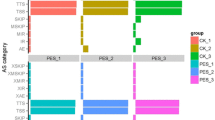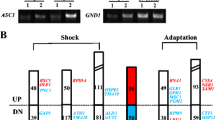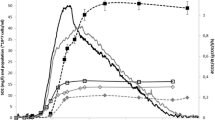Abstract
Sulfite is a commonly used preservative in foods, beverages, and Pharmaceuticals because it is toxic to many microorganisms. In order to understand the global response of Saccharomyces cerevisiae to sulfite, genome-wide transcript profiling following sulfite exposure was obtained. The transcription levels of 21 genes were increased more than 2-fold, while those of 37 genes decreased to a similar extent. Genes involved in carbohydrate metabolism represented the highest proportion of induced genes, which may account for the easily acquired resistance to sulfite. Most of down-regulated genes are involved in transcription, protein biosynthesis, and cell growth. The down-regulation of these genes is thought to reflect growth arrest which occurs during sulfite treatment, allowing cells to save energy. Cells treated with sulfite generated more than 70% of acetaldehyde than untreated cells, suggesting that the increased acetaldehyde production is correlated with the induction of PDC1 gene encoding pyruvate decarboxylase.
Similar content being viewed by others
References
Alexandre, H., V. Ansanay-Galeote, S. Dequin, and B. Blondin. 2001. Global gene expression during short-term ethanol stress in Saccharomyces cerevisiae. FEBS Lett. 498, 98–103.
Aranda, A. and M.L. Del Olmo. 2004. Exposure of Saccharomyces cerevisiae to acetaldehyde induces sulfur amino acid metabolism and polyamine transporter genes, which depend on Met4p and Haa1p transcription factors, respectively. Appl. Environ. Microbiol. 70, 1913–1922.
Avram, D. and A.T. Bakalinsky. 1997. SSU1 encodes a putative transporter with a central role in a network of proteins conferring sulfite tolerance in Saccharomyces cerevisiae. J. Bacteriol. 179, 5971–5974.
Boulton, R.B. and V.L. Singleton. 1995. The role of sulfur dioxide in wine, p. 448–437. In L.F. Bisson and R.E. Kunkee (eds.), Principles and practices of wine making. Chapman and Hall, New York, N.Y., USA.
Caba, E., D.A. Dickinson, G.R. Warnes, and J. Aubrecht. 2005. Differentiating mechanisms of toxicity using global gene expression analysis in Saccharomyces cerevisiae. Mutat. Res. 575, 34–46.
Casalone, E., C.M. Colella, S. Daly, E. Gallori, L. Moriani, and M. Polsinelli. 1992. Mechanism of resistance to sulphite in Saccharomyces cerevisiae. Curr. Genet. 22, 435–440.
Casalone, E., C.M. Colella, E Ricci, and M. Polsinelli. 1989. Isolation and characterization of Saccharomyces cerevisiae mutants resistant to sulphite. Yeast 5, S287–291.
Chang, I.S., B.H. Kim, and P.K. Shin. 1997. Use of sulfite and hydrogen peroxide to control bacterial contamination in ethanol fermentation. Appl. Environ. Microbiol. 63, 1–6.
Compagno, C., L. Brambilla, D. Capitanio, E Boschi, B.M. Banzi, and D. Porro. 2001. Alterations of the glucose metabolism in a triose phosphate isomerase-negative Saccharomyces cerevisiae mutant. Yeast 18, 663–670.
Gasch, A.P. and M. Werner-Washburne. 2002. The genomics of yeast responses to environmental stress and starvation. Funct. Integr. Genomics 2, 181–192.
Gunnison, A.F. and D.W. Jacobson. 1987. Sulfite hypersensitivity: a critical review. CRC Crit. Rev. Toxi. 17, 185–214.
Hinze, H. and H. Holzer. 1986. Analysis of the energy metabolism after incubation of Saccharomyces cerevisiae with sulfite or nitrite. Arch. Microbiol. 145, 27–31.
Jelinsky, S.A. and L.D. Samson. 1999. Global response of Saccharomyces cerevisiae to an alkylating agent. Proc. Natl. Acad. Set USA 96, 1486–1491.
Lee, M.W., B.J. Kim, H.K. Choi, M.J. Ryu, S.B. Kim, K.M. Kang, E.J. Cho, W. Youn, W.K. Huh, and S.T. Kim. 2007. Global protein expression profiling of budding yeast in response to DNA damage. Yeast 24, 145–154.
Maier, K., H. Hinze, and L. Leuschel. 1986. Mechanism of sulfite action on the energy metabolism of Saccharomyces cerevisiae. Biochim. Biophys. Acta. 848, 120–130.
Meng, Z., G. Qin, B. Zhang, and J. Bai. 2004. DNA damaging effects of sulfur dioxide derivatives in cells from various organs of mice. Mutagenesis 19, 465–468.
Ough, C.S. 1993. Sulfur dioxide and sulfites, p. 137–190. In P.M. Davidson and A.L. Branen (eds.), Antimicrobials in Foods. Marcel Dekker Inc., New York, N.Y., USA.
Overkamp, K.M., B.M. Bakker, P. Kötter, M.A. Luttik, J.P. Van Dijken, and J.T. Pronk. 2002. Metabolic engineering of glycerol production in Saccharomyces cerevisiae. Appl. Environ. Microbiol. 68, 2814–2821.
Ozcan, S. and M. Johnston. 1999. Function and regulation of yeast hexose transporters. Microbiol. Mol. Biol. Rev. 63, 554–569.
Park, H. and A.T. Bakalinsky. 2000. SSU1 mediates sulfite efflux in Saccharomyces cerevisiae. Yeast 16, 881–888.
Park, H., N.I. Lopez, and A.T. Bakalinsky. 1999. Use of sulfite resistance in Saccharomyces cerevisiae as a dominant selectable marker. Curr. Genet. 36, 339–344.
Pilkington, B.J. and A.H. Rose. 1988. Reactions of Saccharomyces cerevisiae and Zygosaccharomyces bailli to sulphite. J. Gen. Bacteriol. 134, 2823–2830.
Prakash, D., H. Hinze, and H. Holzer. 1986. Synergistic effect of m-chloro-peroxybenzoic acid, sulfite and nitrite on the energy metabolism of Saccharomyces cerevisiae. FEMS Microbiol. Lett. 34, 305–308.
Pronk, J.T., H.Y de Steensma, and J.P. Van Dijken. 1996. Pyruvate metabolism in Saccharomyces cerevisiae. Yeast 12, 1607–1633.
Reist, M., P. Jenner, and B. Halliwell. 1998. Sulphite enhances peroxynitrite-dependent alpha1-antiproteinase inactivation: A mechanism of lung injury by sulphur dioxide? FEBS Lett. 423, 231–234.
Reverter-Branchat, G., E. Cabiscol, J. Tamarit, M.A. Sorolla, M. Angeles De La Torre, and J. Ros. 2007. Chronological and replicative life-span extension in Saccharomyces cerevisiae by increased dosage of alcohol dehydrogenase 1. Microbiology 153, 3667–3676.
Schaff-Gerstenschläger, I., G. Mannhaupt, I. Vetter, F.K. Zimmermann, and H. Feldmann. 1993. TKL2, a second transketolase gene of Saccharomyces cerevisiae. Cloning, sequence and deletion analysis of the gene. Eur. J. Biochem. 217, 487–492.
Schaufler, L.E. and R.E. Klevit. 2003. Mechanism of DNA binding by the ADR1 zinc finger transcription factor as determined by SPR. J. Mol. Biol. 329, 931–939.
Schimz, K.S. and H. Holzer. 1979. Rapid decrease of ATP content in intact cells of Saccharomyces cerevisiae after incubation with low concentrations of sulfite. Arch. Microbiol. 125, 89–95.
Schmitt, H.D, M. Ciriacy, and F.K. Zimmermann. 1983. The synthesis of yeast pyruvate decarboxylase is regulated by large variations in the messenger RNA level. Mol. Gen. Genet. 192, 247–252.
Shenton, D., J.B. Smirnova, J.N. Selley, K. Carroll, S.J. Hubbard, G.D. Pavitt, M.P. Ashe, and C.M. Grant. 2006. Global translational responses to oxidative stress impact upon multiple levels of protein synthesis. J. Biol. Chem. 281, 29011–29021.
Sirisattha, S., Y. Momose, E. Kitagawa, and H. Iwahashi. 2004. Toxicity of anionic detergents determined by Saccharomyces cerevisiae microarray analysis. Water Res. 38, 61–70.
Taylor, S.L., N.A. Higley, and R.K. Bush. 1986. Sulfites in foods: uses, analytical methods, residues, fate, exposure assessment, metabolism, toxicity, and hypersensitivity. Adv. Food Res. 30, 1–76.
Ter Linde, J.J., H. Liang, R.W. Davis, W. Steensma, J.P. Van Dijken, and J.T. Pronk. 1999. Genome-wide transcriptional analysis of aerobic and anaerobic chemostat cultures of Saccharomyces cerevisiae. J. Bacteriol. 181, 7409–7413.
Thomas, D., R. Barbey, D. Henry, and Y. Surdin-Kerjan. 1992. Physiological analysis of mutants of Saccharomyces cerevisiae impaired in sulphate assimilation. J. Gen. Microbiol. 138, 2021–2028.
Walther, K. and H. Schüller. 2001. Adr1 and Cat8 synergistically activate the glucose-regulated alcohol dehydrogenase gene ADH2 of the yeast Saccharomyces cerevisiae. Microbiology 147, 2037–2044.
Waters, B.M. and D.J. Eide. 2002. Combinatorial control of yeast FET4 gene expression by iron, zinc, and oxygen. J.Biol. Chem. 277, 33749–33757.
Wu, H., X. Zheng, Y. Araki, H. Sahara, H. Takagi, and H. Shimoi. 2006. Global gene expression analysis of yeast cells during sake brewing. Appl. Environ. Microbiol. 72, 7353–7358.
Zhang, X., A.S. Vincent, B. Halliwell, and K.P. Wong. 2004. A mechanism of sulfite neurotoxicity: Direct inhibition of glutamate dehydrogenase. J. Biol. Chem. 279, 43035–43045.
Author information
Authors and Affiliations
Corresponding author
Rights and permissions
About this article
Cite this article
Park, H., Hwang, YS. Genome-wide transcriptional responses to sulfite in Saccharomyces cerevisiae . J Microbiol. 46, 542–548 (2008). https://doi.org/10.1007/s12275-008-0053-y
Received:
Accepted:
Published:
Issue Date:
DOI: https://doi.org/10.1007/s12275-008-0053-y




